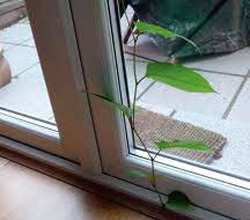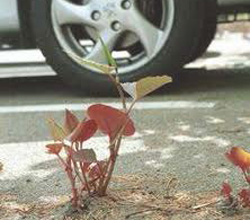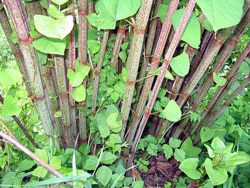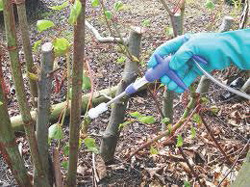"Japanese Knotweed is classified as ‘controlled waste’ - We are professionals in the field of its control, eradication and disposal for clients across the UK."



JAPANESE KNOTWEED
Japanese knotweed was introduced into Britain in the 19th century as an ornamental plant. Over time it has become widespread in a range of habitats, including roadsides, riverbanks and derelict buildings. It outcompetes native plants and animals. Japanese Knotweed is Britain's most invasive non-native plant.
The Wildlife and Countryside Act 1981 states that it is an offence to "plant or otherwise cause to grow in the wild" any plant listed in Schedule nine, Part II of the Act. This lists over 30 plants including Japanese knotweed, giant hogweed and parrot's feather. It's down to landowners to control these plants, causing the plants to spread by removing or disposing of them incorrectly would be illegal.
Japanese Knotweed Domestic Control
Japanese Knotweed is an attractive plant and was originally brought into the UK in 1825 by the Victorians. Gardeners soon discovered how difficult it was to keep under control and by 1886 the plant had escaped from gardens and had become naturalized throughout the UK.
If you suspect you have Japanese Knotweed on your property you should take care not to allow it to spread. Even the smallest piece of rhizome, stem or crown can potentially form a new plant. It's down to landowners to control these plants. However, causing the plants to spread by removing or disposing of them incorrectly would be illegal.
Commercial Knotweed Removal
Development Sites
Japanese Knotweed has the potential to be a serious problem for developers due to its persistent nature and the need to comply with the law. To help prevent the possibility of breaking the law and incurring large fines it is important that you address the problem of Japanese Knotweed if it is present on site. Early identification of contaminated areas is essential. Plans must be prepared to contain, control and remove Japanese Knotweed with clear methods of working to prevent its spread.
Japanese Knotweed Removal
To remove the Japanese knotweed you should closely follow the advice given by the Environment Agency provided in the knotweed code of practice, or employ a contractor such us ourselves.We have the machinery and expertise to legally control and manage Japanese Knotweed on your land.
Stem Injection
We are expertly trained and experienced in stem injection, this works by injecting a small measured dose of herbicide into each cane of the Japanese Knotweed infestation. Cameron is qualified to carry out the treatment and holds the required National Proficiency Tests Council (NPTC) certification.
Physical Control
Japanese Knotweed can be controlled to a degree with an agressive cutting program, which we can implement to ensure maximum effect.
Japanese Knotweed Disposal
Japanese Knotweed and only be disposed of under strict restrictions at specific sites. We are fully aware of the legislation and so will ensure that any plants are disposed of within the law. Japanese Knotweed material is regarded as ‘controlled waste’ and not disposing of it properly would be an offence under the Environmental Protection Act, 1990
To enquire about rates for this service please either phone Cameron on 07721 518382 or 01271 870612 or email info@campbellequestrian.co.uk where we will be happy to chat about your requirements.
JAPANESE KNOTWEED AND THE LAW
Japanese knotweed is a very invasive plant and can very easily get out of control if not dealt with. By law if you have Japanese Knotweed on your land you are responsible to get control and remove it legally.
Environmental Protection Act 1990
Japanese Knotweed is classed as ‘controlled waste’ and as such must be disposed of safely at a licensed landfill site according to the Environmental Protection Act (Duty of Care) Regulations 1991. Soil containing rhizome material can be regarded as contaminated and, if taken off a site, must be disposed of at a suitably licensed landfill site and buried to a depth of at least 5 m.
An offence under the Wildlife and Countryside Act can result in a criminal prosecution. An infringement under the Environmental Protection Act can result in enforcement action being taken by the Environment Agency which can result in an unlimited fine. You can also be held liable for costs incurred from the spread of Knotweed into adjacent properties and for the disposal of infested soil off site during development which later leads to the spread of Knotweed onto another site.
JAPANESE KNOTWEED TREATMENTS WE OFFER
We are able to offer a couple of control methods which include physical control and chemical control methods.
Chemical Control

Physical Control
JAPANESE KNOTWEED USEFUL LINKS
Detailed Image of Japanese Knotweed
EQUIPMENT AVAILABLE




